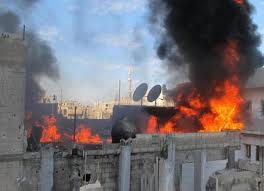 A Red Cross team evacuated seven people from a besieged neighborhood in the Syrian city of Homs Friday but apparently failed to get out two wounded Western journalists and the bodies of two others killed by government rockets.
A Red Cross team evacuated seven people from a besieged neighborhood in the Syrian city of Homs Friday but apparently failed to get out two wounded Western journalists and the bodies of two others killed by government rockets.
The International Committee of the Red Cross said a local team entered the besieged neighborhood of Baba Amr and transferred seven people to the privately owned al-Amin hospital, which is nearby. But spokesman Hicham Hassan said he wasn’t sure if foreign journalists were among them.
Later, The Syrian Foreign Ministry accused “armed groups” of refusing to hand over the journalists, and an opposition activist in the area said the journalists had refused to leave.
French journalist Edith Bouvier of Le Figaro and British photographer Paul Conroy of the Sunday Times both asked for help leaving the embattled city after they were wounded in a government attack on a makeshift media center Wednesday. French photographer William Daniels, who was not injured, was also with the group, as was Spanish journalist Javier Espinosa.
American correspondent Marie Colvin, also of the Sunday Times, and French photographer Remi Ochlik were killed in the same attack.
The effort to evacuate the reporters and wounded Syrians is part of a wider international push to bring aid to people in the areas hardest hit by the regime’s efforts to quash the uprising against President Bashar Assad’s rule.
But the inability of the Red Cross to navigate the tremendous hatred and distrust between Assad’s regime and opposition activists seeking to overthrow it does not bode well for future international efforts to help those suffering the most in the country’s 11-month-old political crisis.
At a high-level international conference Friday in Tunisia, American, European and Arab nations asked the United Nations to plan a civilian peacekeeping mission to deploy after Assad’s regime halts its brutal crackdown. It also called on Assad to end the violence and allow humanitarian aid to reach embattled areas.
Workers from the local branch of the Red Cross entered one of those areas Friday, Baba Amr in Homs, to negotiate the evacuation of wounded civilians with Syrian authorities and opposition groups.
In a statement, the Syrian Foreign Ministry accused “armed groups” in Baba Amr of refusing to hand over a wounded female journalist and the dead bodies of two other journalists. Syrian authorities regularly blame the violence on radical Islamists and “armed gangs.”
The Foreign Ministry said the government had sent several local “dignitaries” and ambulances from the Syrian Red Crescent to evacuate the journalists.
But after several hours of negotiations, the statement said, the groups “refused to hand over the wounded journalist and the two bodies, which endangers the life of the French journalist and blocks the return of the bodies to their countries.”
A local activist, Abu Mohammed Ibrahim, reached on Skype, said the journalists had refused to leave because the ICRC did not enter, only the Syrian Red Cresent, which he said is full of “collaborators with the regime.”
“The journalists also refused to give over the bodies,” he said. “They don’t know what the government is going to do with them.”
He said the four journalists remained in the city, each staying in a different apartment, and that the two dead bodies are being kept in yet another apartment, where they have begun to decay.
The Geneva-based International Committee of the Red Cross did not immediately respond to a request for comment about the claim.
Speaking at the Tunisia conference, French Foreign Minister Alain Juppe said Syrian authorities had refused a request to tell the French Ambassador to Syria travel to Homs to arrange the evacuation.
“I appeal personally to the Syrian authorities that Madame Bouvier and the others receive the medical care they urgently need,” he said.
One video posted on YouTube on Wednesday showed Bouvier lying on a hospital gurney with a white cast stretching from her left ankle to her thigh. Conroy is on a nearby bed, with white bandages around his left thigh and calf. The video says he was injured by shrapnel from the rocket attack.
In another video, posted Thursday, Bouvier is covered with a blanket and lying on a couch. She says her leg is broken in two places and that she needs an operation that local medics cannot perform.
“I need, as soon as possible, a cease-fire and a medically equipped car in good condition to drive us to Lebanon,” she says.
Daniels stands at her side and pleads for their swift evacuation.
“It is difficult here. We don’t have electricity. We don’t have much to eat. The bombs continue to fall,” he said, adding that they only have Internet access in a dangerous place on the neighborhood’s edge.
A boom is heard outside as he speaks.
Conroy appears in a third video, also posted Thursday. Lying on couch, he says he has three large wounds in his leg.
“I am currently being looked after by the Free Syrian Army medical staff who are treating me with the best medical treatment available,” he says, referring to armed opposition forces.
“It’s important that I am here as a guest and not captured,” he says. “I am absolutely OK.”
The Syrian uprising, which began last March with protests in some of Syria’s impoverished hinterlands, is evolving into one of the most violent of the Arab Spring. Assad’s security forces have used extreme force against protesters, and the opposition is increasingly taking up arms.
The U.N. said last month that 5,400 people had been killed. Hundreds more have died since. Activists put the number at more than 7,300, but overall figures are impossible to confirm independently.
AP
Leave a Reply
You must be logged in to post a comment.